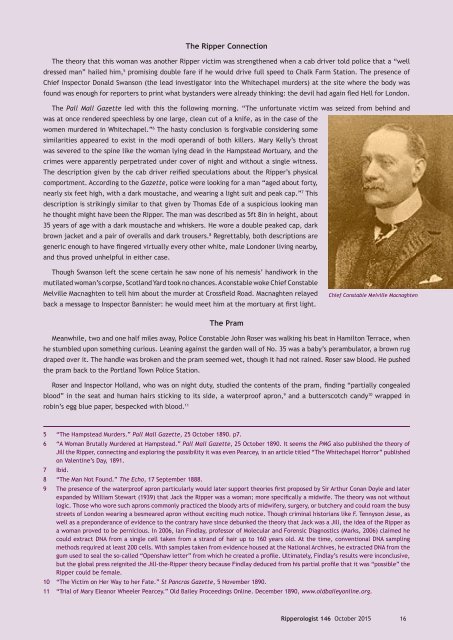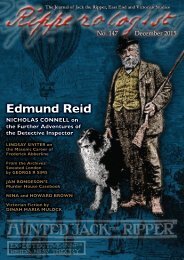GEORGE HUTCHINSON
orxwju5
orxwju5
You also want an ePaper? Increase the reach of your titles
YUMPU automatically turns print PDFs into web optimized ePapers that Google loves.
The Ripper Connection<br />
The theory that this woman was another Ripper victim was strengthened when a cab driver told police that a “well<br />
dressed man” hailed him, 5 promising double fare if he would drive full speed to Chalk Farm Station. The presence of<br />
Chief Inspector Donald Swanson (the lead investigator into the Whitechapel murders) at the site where the body was<br />
found was enough for reporters to print what bystanders were already thinking: the devil had again fled Hell for London.<br />
The Pall Mall Gazette led with this the following morning. “The unfortunate victim was seized from behind and<br />
was at once rendered speechless by one large, clean cut of a knife, as in the case of the<br />
women murdered in Whitechapel.” 6 The hasty conclusion is forgivable considering some<br />
similarities appeared to exist in the modi operandi of both killers. Mary Kelly’s throat<br />
was severed to the spine like the woman lying dead in the Hampstead Mortuary, and the<br />
crimes were apparently perpetrated under cover of night and without a single witness.<br />
The description given by the cab driver reified speculations about the Ripper’s physical<br />
comportment. According to the Gazette, police were looking for a man “aged about forty,<br />
nearly six feet high, with a dark moustache, and wearing a light suit and peak cap.” 7 This<br />
description is strikingly similar to that given by Thomas Ede of a suspicious looking man<br />
he thought might have been the Ripper. The man was described as 5ft 8in in height, about<br />
35 years of age with a dark moustache and whiskers. He wore a double peaked cap, dark<br />
brown jacket and a pair of overalls and dark trousers. 8 Regrettably, both descriptions are<br />
generic enough to have fingered virtually every other white, male Londoner living nearby,<br />
and thus proved unhelpful in either case.<br />
Though Swanson left the scene certain he saw none of his nemesis’ handiwork in the<br />
mutilated woman’s corpse, Scotland Yard took no chances. A constable woke Chief Constable<br />
Melville Macnaghten to tell him about the murder at Crossfield Road. Macnaghten relayed<br />
back a message to Inspector Bannister: he would meet him at the mortuary at first light.<br />
Chief Constable Melville Macnaghten<br />
The Pram<br />
Meanwhile, two and one half miles away, Police Constable John Roser was walking his beat in Hamilton Terrace, when<br />
he stumbled upon something curious. Leaning against the garden wall of No. 35 was a baby’s perambulator, a brown rug<br />
draped over it. The handle was broken and the pram seemed wet, though it had not rained. Roser saw blood. He pushed<br />
the pram back to the Portland Town Police Station.<br />
Roser and Inspector Holland, who was on night duty, studied the contents of the pram, finding “partially congealed<br />
blood” in the seat and human hairs sticking to its side, a waterproof apron, 9 and a butterscotch candy 10 wrapped in<br />
robin’s egg blue paper, bespecked with blood. 11<br />
5 “The Hampstead Murders.” Pall Mall Gazette, 25 October 1890. p7.<br />
6 “A Woman Brutally Murdered at Hampstead.” Pall Mall Gazette, 25 October 1890. It seems the PMG also published the theory of<br />
Jill the Ripper, connecting and exploring the possibility it was even Pearcey, in an article titled “The Whitechapel Horror” published<br />
on Valentine’s Day, 1891.<br />
7 Ibid.<br />
8 “The Man Not Found.” The Echo, 17 September 1888.<br />
9 The presence of the waterproof apron particularly would later support theories first proposed by Sir Arthur Conan Doyle and later<br />
expanded by William Stewart (1939) that Jack the Ripper was a woman; more specifically a midwife. The theory was not without<br />
logic. Those who wore such aprons commonly practiced the bloody arts of midwifery, surgery, or butchery and could roam the busy<br />
streets of London wearing a besmeared apron without exciting much notice. Though criminal historians like F. Tennyson Jesse, as<br />
well as a preponderance of evidence to the contrary have since debunked the theory that Jack was a Jill, the idea of the Ripper as<br />
a woman proved to be pernicious. In 2006, Ian Findlay, professor of Molecular and Forensic Diagnostics (Marks, 2006) claimed he<br />
could extract DNA from a single cell taken from a strand of hair up to 160 years old. At the time, conventional DNA sampling<br />
methods required at least 200 cells. With samples taken from evidence housed at the National Archives, he extracted DNA from the<br />
gum used to seal the so-called “Openshaw letter” from which he created a profile. Ultimately, Findlay’s results were inconclusive,<br />
but the global press reignited the Jill-the-Ripper theory because Findlay deduced from his partial profile that it was “possible” the<br />
Ripper could be female.<br />
10 “The Victim on Her Way to her Fate.” St Pancras Gazette, 5 November 1890.<br />
11 “Trial of Mary Eleanor Wheeler Pearcey.” Old Bailey Proceedings Online. December 1890, www.oldbaileyonline.org.<br />
Ripperologist 146 October 2015 16




